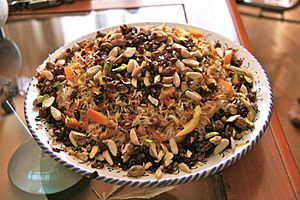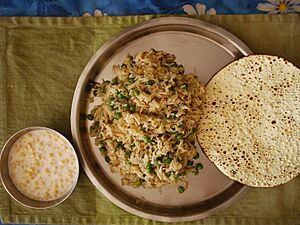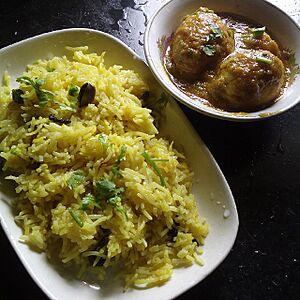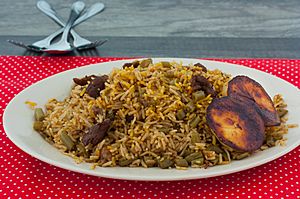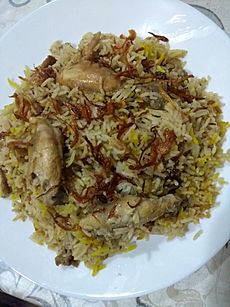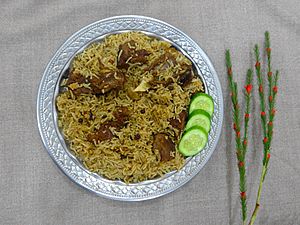Pilaf facts for kids
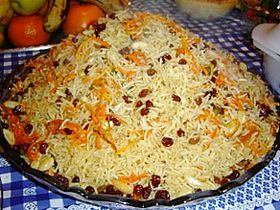
Kabuli palaw, the national dish of Afghanistan
|
|
| Alternative names | Polao, Plao, Pela, Pilav, Pallao, Pilau, Pelau, Pulao, Palau, Pulaav, Palaw, Palavu, Plov, Palov, Polov, Polo, Polu, Kurysh, Fulao, Fulaaw, Fulav, Fulab, Osh, Aş, Paloo, Kürüch |
|---|---|
| Course | Main |
| Region or state | Balkans, Caribbean, South Caucasus, Central Asia, East Africa, Eastern Europe, South Asia, Latin America, Middle East |
| Serving temperature | Hot |
| Main ingredients | Rice, stock or broth, spices, meat, vegetables, dried fruits |
Pilaf (also spelled pilau) is a yummy dish usually made with rice. Sometimes, it's made with wheat instead. The special thing about pilaf is how it's cooked. The rice is simmered in a tasty broth or stock. Cooks add spices, vegetables, or meat to make it even more delicious. The goal is for each grain of rice to stay separate and fluffy, not sticky!
Pilaf and similar dishes are popular in many parts of the world. You can find them in places like the Balkans, the Caribbean, Central Asia, and the Middle East. It's a main food in countries such as Afghanistan, Turkey, India, and Uzbekistan.
Contents
What's in a Name?
The word pilaf comes from the Turkish word pilav. This word itself came from the Persian word pilāv.
The spelling pilau (used in the United Kingdom) comes from the Hindi word pulāv. This word might have come from an older Sanskrit word for a ball of rice.
A Quick History of Pilaf
Rice farming spread from South Asia to Central Asia a long time ago. But it was during the time of the Abbasid Caliphate (a big empire from the 9th to 13th centuries) that special ways of cooking rice, like pilaf, became popular. These cooking methods spread across a huge area, from India all the way to Spain.
Some people say that Alexander the Great and his army liked pilaf so much in the 4th century BCE that they brought the recipes back to Macedonia. However, this story might not be true.
The first written recipe for pilaf comes from a Persian scholar named Avicenna. He lived in the 10th century and wrote about how to make different kinds of pilaf. He even explained the good and bad points of each ingredient! Because of this, many people call Avicenna the "father" of modern pilaf. Old texts from the 13th century say that pilaf grains should be plump and firm, not mushy or clumpy.
Over time, pilaf became a common dish in the Middle East. Different cultures like the Persians, Arabs, Turks, and Armenians added their own special touches. During the time of the Soviet Union, Central Asian pilaf dishes became popular in all the Soviet countries.
How Pilaf is Made
Many cooks like to use basmati rice for pilaf. This type of rice helps the grains stay "light, fluffy, and separate." But other long-grain rice types work too.
Before cooking, the rice is usually rinsed well to remove extra starch. Pilaf can be cooked in water or a flavorful broth. Common things added to pilaf include:
- Fried onions
- Fragrant spices like cardamom, bay leaves, and cinnamon
- Meat (like chicken or lamb)
- Vegetables
Sometimes, saffron is added to give the rice a beautiful yellow color. Often, the rice is briefly stirred in hot oil or butter before the liquid is added. The way pilaf is cooked can change a bit. Some recipes soak the rice first, and some steam it after boiling.
Many Kinds of Pilaf
There are thousands of different pilaf recipes! They can be made with rice or other grains like bulgur (cracked wheat). Some have different meats, fruits, or vegetables. Others are very simple. Today, the main styles of pilaf come from Central Asia, India, Turkey, Iran, and the Caribbean.
Afghanistan
In Afghan cuisine, a famous pilaf is called Kabuli palaw. It's made with basmati rice and meat like mutton, lamb, beef, or chicken. Fried carrots and raisins are often added. Sometimes, chopped nuts like pistachios or almonds are included too. The meat is usually hidden under the rice. This dish is also popular in Saudi Arabia, where it's called roz Bukhari.
Armenia

Armenians often use bulgur (cracked wheat) in their pilaf dishes. Armenian recipes might mix vermicelli or orzo pasta with rice. They cook it in broth seasoned with mint, parsley, and allspice. One traditional Armenian pilaf has noodles, rice, raisins, almonds, and allspice.
Azerbaijan
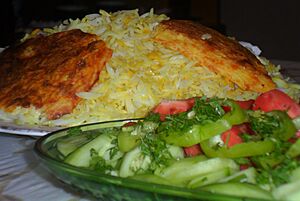

Azerbaijani cuisine has over 40 different pilaf recipes! A famous one is saffron-covered rice served with herbs. Traditional Azerbaijani pilaf has three parts served separately: the warm rice, gara (fried meat with onions, chestnuts, and dried fruits), and herbs. You mix them on your plate when you eat.
Bangladesh
In Bangladesh, pulao is a popular dish for special events. It's made with fragrant rice. The rice is first fried in oil or butter with onions, ginger, and spices like cardamom and cinnamon. Then it's cooked in broth or water. Chicken pulao is a traditional dish for Bangladeshi Muslims.
A very spicy dish called tehari is also popular in Bangladesh. It's often made with beef or goat meat. Small potatoes, mustard oil, and a special spice mix make it unique.
Caribbean
In the Eastern Caribbean, there are many kinds of pelau. These can include pigeon peas, green peas, corn, carrots, pumpkin, and meats like beef or chicken. The seasoned meat is usually cooked first, then the rice and vegetables are added. Coconut milk and spices are also important in some islands.
Trinidad is known for its pelau. It mixes traditional African cuisine with new ingredients. Browning the meat in sugar is an African cooking method.
Central Asia

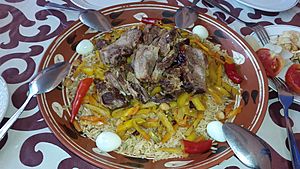
In Central Asia, like Uzbekistan and Tajikistan, pilaf is called palov or osh. Here, the rice is not steamed. Instead, it's simmered in a rich stew of meat and vegetables called zirvak. The liquid is absorbed into the rice. It's often cooked in a large pot called a kazon over an open fire.
Common ingredients include lamb browned in fat or oil, then stewed with fried onions, garlic, and carrots. Spices like cumin, coriander, and barberries are often used. Sweet versions with dried apricots and raisins are made for special events.
Palov is often made by an oshpaz (master chef) for big gatherings like weddings. They can cook for up to 1,000 people in one pot!
Greece
In Greek cuisine, piláfi is fluffy and soft. It's made by boiling rice in meat stock or broth. In Northern Greece, it's often cooked in the oven. Gamopílafo ("wedding pilaf") is a special pilaf served at weddings in Crete. It's made with lamb or goat broth and finished with lemon juice.
India

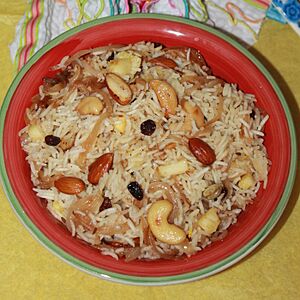
In India, Pulao is usually a mix of lentils or vegetables (like peas, potatoes, carrots) or meat (chicken, fish, lamb) with rice. A typical Bengali style pulao uses fragrant rice, cashewnuts, raisins, saffron, ghee (clarified butter), and spices.
There are also very fancy pulaos with Persian names. Pulao is often served at special events and weddings. It's usually eaten with spiced yogurt or raita.
Iran
In Persian cuisine, there are many ways to cook rice.
- Chelow: Rice that is soaked, partly boiled, then steamed. This makes very fluffy, separate grains. It also creates a crispy golden crust at the bottom called tahdig.
- Polow: Cooked like chelow, but other ingredients are layered with the rice and steamed together.
- Kateh: Rice that is boiled until the water is absorbed. This is a traditional dish from Northern Iran.
Pakistan
In Pakistan, Pulao is a popular dish made with basmati rice and meat, usually mutton or beef. It's cooked in a seasoned broth with spices like coriander seeds, cumin, and cardamom. Like in Afghanistan, Kabuli palaw is common in western Pakistan. It's often decorated with sliced carrots, almonds, and raisins.
Pulao is famous all over Pakistan, but the cooking style can be a little different in various regions.
Turkey
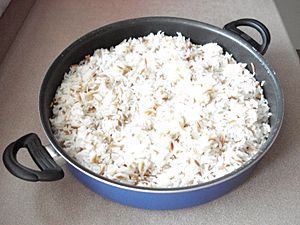
Turkish cuisine has many types of pilaf. Some common ones are pirinc (rice) pilaf, bulgur pilaf, and arpa şehriye (orzo) pilaf. Turkish people also make dishes like etli pilav (rice cooked with cubed beef). In Turkey, if the rice is sticky, it's not considered a good pilaf. To make the best Turkish pilaf, the rice is rinsed, cooked in butter, then water is added, and it sits until all the water is soaked up. This makes each grain separate and fluffy.
Images for kids
See also
 In Spanish: Pilaf (comida) para niños
In Spanish: Pilaf (comida) para niños


